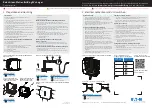
d) If battery acid contacts skin or clothing, wash immediately with soap and water. If acid enters eye, immediately flood eye with running cold
water for at least 10 minutes and get medical attention immediately.
e) Never smoke or allow a spark or flame in vicinity of battery, engine, motor or other flammable or explosive equipment.
f) Be extra cautious to reduce risk of dropping a metal tool onto battery. It might spark or short circuit battery or other electrical part that may
cause explosion.
g) Remove personal metal items such as rings, bracelets, necklaces, and watches when working with a lead acid battery. A lead acid battery
can produce a short circuit current high enough to weld such items, causing severe burns.
h) Use the Minn Kota battery charger for charging and maintaining FLOODED / WET CELL, MAINTENANCE FREE, AND AGM / STARVED
ELECTROLYTE batteries only. It is not intended to supply power to low voltage electrical systems other than for charging and maintaining
batteries. Do not use the charger for charging dry-cell batteries that are commonly used with home appliances. These batteries may burst
and cause injury to persons and damage to property.
i) NEVER charge a frozen battery.
3) PREPARING TO CHARGE
a) If necessary to remove battery from boat or vehicle to charge or maintain, always remove grounded terminal from battery first (if applicable).
Make sure all accessories in the boat or vehicle are off, so as not to cause an arc.
b) Be sure area around battery is well ventilated while battery is being charged or maintained.
c) Clean battery terminals. Be careful to keep corrosion from coming in contact with eyes.
d) Add distilled water in each cell until battery acid reaches level specified by battery manufacturer. Do not overfill. For a battery without remov-
able cell caps, such as valve regulated lead acid batteries, carefully follow manufacturer’s recharging instructions.
e) Study all battery manufacturers’ specific precautions and recommended rates of charge while charging.
4) DC AND AC CONNECTION PRECAUTIONS
a) The Minn Kota charger will only charge 12 volt 6 cell lead acid batteries. Do not connect the output of the charger to any other voltage or
type of battery.
b) The charger’s DC output leads are designed to be temporarly connected to the battery.
c) Connect and disconnect DC output leads only after removing the AC plug from the electric outlet.
d) The charger output leads must be connected with the correct polarity for the charger to function. The RED lead must be connected to the
POSITIVE terminal of the battery and the BLACK lead must be connected to the NEGATIVE terminal of the battery.
5) CHOOSING THE CHARGING LOCATION
a) The input (AC) power cord is 6 feet long and the output (DC) battery leads are also 6 feet long. Make sure that all the DC battery leads can reach
the batteries and that the AC power cord can reach the power source. Do not splice any battery lead or power cord, as this voids the three year
Limited Warranty.
b) Even though the Minn Kota charger is capable of operating in a high ambient temperature environment, a minimum of 6 inches of unobstructed area
should be allowed on all sides of the unit for proper air circulation and cooling. Proper cooling and circulation will allow the charger to operate at peak
efficiency.
CONNECTING THE BATTERIES TO THE CHARGER:
DANGER
– Never alter AC cord or plug provided – if it will not fit outlet, have proper outlet installed by a qualified electrician. Improper connec-
tion can result in a risk of an electric shock.
3
CAUTION
- Before making any connections to batteries in a confined space, open the door or hatch of the compartment and allow it to air out
for 15 minutes. This allows any gasses that have accumulated in the compartment to escape.
WARNING
– MAKE SURE THE CHARGER IS DISCONNECTED FROM AC POWER AND THE ON/OFF SWITCH IS IN THE OFF POSITION
BEFORE CONNECTING THE BATTERY TO THE OUTPUT LEADS.


























